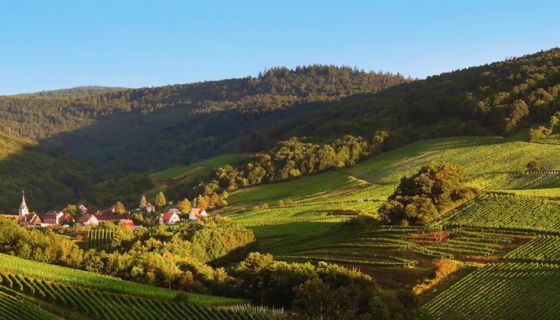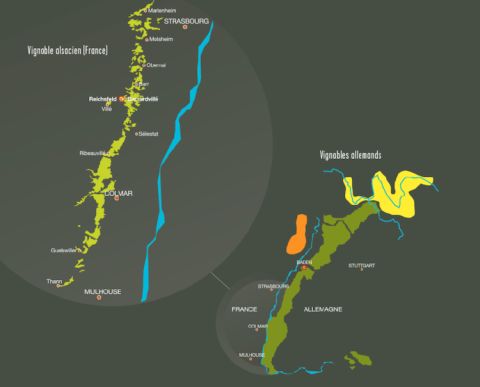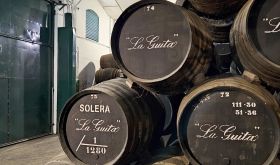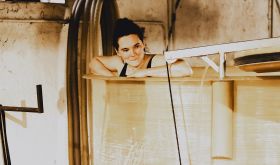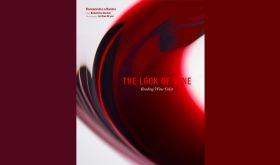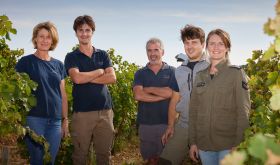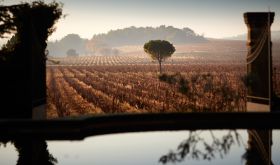Lieu-Dit Fels from £26.68, €34
Lieu-Dit Berg from €29, 285 Danish kroner
Lieu-Dit Buehl from €29, £29.95, NZ$69
These three organically certified single-vineyard Rieslings are a delicious foretaste of the more than 100 Alsace wines that Tam and I tasted as part of the Alsace digital tasting in June, all from little sample bottles efficiently dispatched to our homes. We will be publishing a full report on those wines in due course.
While the front labels of the Schieferkopf wines no longer include the words ‘par Michel Chapoutier’, as they did on earlier vintages, Schieferkopf is still very much part of the M Chapoutier empire beyond the Rhône Valley, where they have been entrenched for far longer than in Alsace, as you can see from the history page of their website. There are also Schieferkopf vineyards in Baden, the Pfalz and Franken over the border in Germany (see their map below), plus estates in Roussillon, the Douro and Australia. See here for the full list of domaines.
The German name – Schieferkopf means ‘slate head’ though the Chapoutier website translates Schiefer as ‘schist’ – signals the dominant subsoil in the 8 ha (20 acres) of vineyards they farm organically in the village of Bernardvillé, within the Bas-Rhin département of Alsace. Apparently it’s the only strip of blue slate in Alsace, to which they attribute the minerality in these wines. Not satisfied with this soil distinction, Chapoutier produce these three single-vineyard (lieu-dit) wines, a parallel with their Sélections Parcellaires series from the Rhône.
The soil and elevation (380 m/1,247 ft), in combination with south and south-east exposition under Alsace’s sunny skies, result in beautifully ripe wines with great freshness, masterful expressions of Alsace Riesling. This short video, from which the image above is taken, reveals the beauty and sweep of these vineyards.
All three wines are dry – Fels and Berg have 0.8 g/l residual sugar, Buehl has 2.2 g/l – and come in at 13 or 13.5%. Even if they show a strong family likeness of power, depth, persistence, freshness and a slightly savoury quality, each has its own personality, which I have tried to capture in my notes below. I scored the Fels and the Berg 17 out of 20 and the Buehl just a little notch higher at 17.5. All should age well in the bottle, as the drink dates guesstimate. Chapoutier suggests they will start to reach their full complexity around five years after bottling, so they are just getting into their stride. Richard tasted the 2017s as cask samples in 2018, and it’s clear from his notes that they were not ready for drinking then.
Lieu-Dit Fels Riesling 2017
Pale gold. Ripe yellow plum though it’s not fruit that marks this wine, more smoky and spicy, with a strong, savoury mineral cast, but deeper than stone dust, deeper underground. Broad, rich and complex, powerful and still finely balanced by the acidity. Dense and very long. 17/20 Drink 2019–2027
Lieu-Dit Berg Riesling 2017
Pale gold. There’s a little more obvious fruit here than on the Fels though here it’s lightly spiced and mineral/stony pear. Very hard to describe this complex aroma. On the palate, this is highly textured and at the same time super-fresh. That savoury character again. Full in the mouth but mouth-watering on the long finish. Tighter core than Fels. Distinctive and delicious. 17/20 Drink 2020–2025
Lieu-Dit Buehl Riesling 2017
Pale gold. Smells rich and golden and spicy. Rich and savoury at the same time. Ripe pear and sour apricot. On the palate, much more cedary than the Fels or Berg, cooler and more green fruited, not as broad in the mouth but full of flavour. Mouth-watering with a persistent salty finish. It’s so easy to drink this complex wine thanks to all that freshness. 17.5/20 Drink 2020–2027
All three wines are made in the same way: they are fermented in tank with ambient yeast and, perhaps rather unusually for Riesling, go through malolactic conversion, which adds to their texture and richness, although Chapoutier suggest that this natural biological process that softens the acidity ‘brings out the minerality from the blue schist terroir’. They are aged for 15 months in foudres (big casks).
These wines are more widely available by the case, as shown in the Wine-Searcher links above. Their UK importer is Hatch Mansfield, who cite stockists in the UK, other than those shown on Wine-Searcher, as: Vino Wines (Scotland), Islington Wine, Wimbledon Wine Cellar and D Byrne and Co. Sad to say the 2017s are not yet on sale in the US though these older vintages are available, imported by Terlato: Berg and Fels 2015, Buehls 2016 (as well as several other Schieferkopf wines).
You can find a further 25 tasting notes on Schieferkopf Rieslings in our database, ranging from 2009 to 2018, almost all with a score of between 16.5 and 18. That’s high praise.

